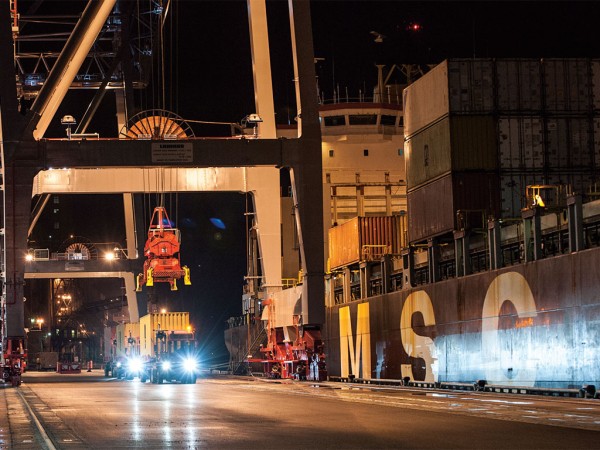Canadian ports of Montreal and Halifax investing for the future.
Canada’s leading container ports on the East Coast, Montreal and Halifax, are both increasing capacity to meet anticipated demand in the years ahead. But while the Port of Montreal is forging ahead resolutely, Halifax is reviewing various options on how to proceed through infrastructure investments to meet the challenges of the new generation of mega box ships now arriving on North America’s eastern seaboard.

The expansion announcement came shortly before the addition of a seventh service of a global carrier in early April operated by Cosco Shipping. The service calls at Antwerp, Bremerhaven, Le Havre before heading to Montreal, its sole port of call in North America. It is operated with 4,800 TEU average ships on OOCL’s GEX1 service. This follows the launch of Hamburg Sud service connecting Montreal to Europe last July and a Maersk Line service to the Mediterranean back in May 2018. These are all signs that, at least in the immediate future, carriers are continuing to wager on Montreal despite its draft limits because ships load and unload all their containers on a single call.
Container volumes through Canada’s second largest port have surged from 1.2 million TEU in 2013 to 1.7 million TEU in 2018 – with a significant part of the recent growth attributed to the 2017 free trade agreement between Canada and the European Union known as CETA.
While reaffirming Montreal as “the major gateway for eastern Canada and the industrial heartland of North America,” Tony Boemi, vice-president of growth and development for the Montreal Port Authority (MPA), stresses the new service also reinforces the need to move forward with the proposed creation of a fifth major box terminal at nearby Contrecoeur on the St. Lawrence River that would add more than 1.1 million TEU to overall capacity within five years.
The new expansion at the Viau Terminal phase will boost its capacity by 250,000 TEU to 600,000 TEU and allow the port to attain a maximum capacity of 2.1 million TEU.
Construction will run from September 2019 to December 2020 and will mainly include the following: installing piles, railway works, dynamic soil compaction, underground infrastructure works, laying foundation, and paving.
Viau Terminal’s final phase has been made possible through large investments from three partners: the MPA, Logistec and the federal government.
Logistec Corporation said that Termont Montreal Inc. is investing C$30 million in the final phase of the key infrastructure project that, in turn, will enable the development and growth of services for the world’s second largest shipping line, MSC, a longstanding partner of both Termont Montreal Inc. and the Port of Montreal.
“The increase in terminal capacity is coming at the right time for us. We applaud this announcement as it ensures the future growth of our services in Montreal,” said Sokat Shaikh, President and CEO of MSC Canada. “MSC has grown significantly by more than 10% a year for the past five years. This additional capacity at Viau Terminal will support such growth over the next two years. Then we will have to move on to the next step.”
Madeleine Paquin, president of Termont Montreal Inc., added: “The Port of Montreal is a hub and anchors our network. As MSC’s strategic partners, we are delighted to work with the Port of Montreal and support its expansion. This project reaffirms our commitment to Montreal and our determination to be efficient and reliable as a strategic gateway for Canadian trade. We are very pleased to have the support of the Government of Canada to continue to advance Montreal’s development. Since the signing of CETA, exporters and importers are already making the most of the new market access. The future is bright for Montreal!”
Halifax Investments
At the Port of Halifax, which handled some 548,000 TEU in 2018, some C$35 million is being spent by the Halifax Port Authority to extend the South End container terminal operated by Halterm by 135 metres with a view to accommodating two ultra large ships simultaneously. Dredging recently started. The terminal is currently handling vessels in the 11,000 TEU category, and Halterm executives see potential for vessels of up to 18,000 TEU in the near future.
In contribution to the big ship program, Halterm has ordered a super post-Panamax, ship-to-shore container gantry crane (due June 2020) and associated lifting equipment such as rubber-tired gantry cranes, terminal tractors and trailers. With a 24-container wise reach, the new super crane will be added to Halterm’s main berth alongside four existing super post-Panamax units and one Panamax crane.
Kim Holtermand, CEO and managing director of Halterm, says the investments will allow Halterm to stay ahead of customer demand and “maintain the flexibility at three deep-water berths to deliver world-class service for vessels from feeders to the ultra-class.”
However, extending Halterm has been what has been qualified as a temporary solution amidst a growing public outcry of Halifax citizens to re-locate the facility altogether to eliminate the flow of approximately 600 trucks daily through the downtown core. Among the options being considered is to build a permanent terminal with rail and laydown areas north of the existing Halterm site.
The HPA recently began an online consultation to determine the future of the Nova Scotia port as Canada’s Ultra Atlantic Gateway.
It was back in 2016 that the HPA initiated a comprehensive infrastructure planning process to determine the best way of capitalizing on great transformations that have been taking place in the global container cargo business. The online platform will be open until April 18. Later this year, the HPA is expected to unveil a more detailed blueprint for the future prior to the planned departure, after long service, of Karen Oldfield as president and CEO.





